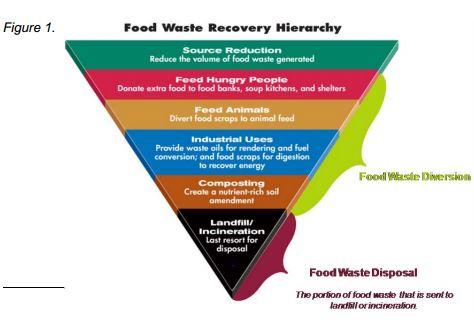The ability to provide enough nutritious food for ourselves, rests upon three pillars, sustainable agriculture, providing nutritious meals and reducing food loss and waste. The Economist’s Food Sustainability Index provides metrics for elements of these components. France, home of the fry, croissant and Burgundy was number one; for the U.S. it was a mixed report.
One measures food loss or waste in multiple ways. As a % of our total food production – the US waste only 0.8% (France wasted 1.8%). Or you might consider food waste per capita, 278 kg/person annually for the U.S., France checks in at 106kg/person/annually. What could account for the differences? Certainly, our food production fed to animals can account for our overall lower food loss, but what about those per capita losses?
The Environmental Protection Agency, among others, has adopted and popularized a hierarchy of food recovery. Listed by diminishing efficacy the components are
- Prevention
- Human consumption (donation or transformation)
- Feed animals
- Food used composting or energy recovery
- Burial in landfills
Prevention refers to trying to match food supply and demand. Always a tricky proposition because there still has to be some slack, or in this case, waste in the system to account for a run on food - like every time it snows and they tell us to stock up on milk and bread. Food that is not eaten can be recovered for composting; we see that in local efforts, even in a city as large as New York. And given a suitable reverse supply chain, excess food can be shared with not just our dogs and cats but returned to the farm.
But what accounted for the most significant difference between the US and France was their simply worded food waste legislation. France, committed to reducing food loss in half by 2025, forbids the destruction of edible food by retailers, restaurants, and groceries. They are required to find a food charity partner and transfer still edible foods to them. U.S. retailers and restaurants have been quietly working in the same direction, without regulation, for some time.
Retailers currently divert 75% of their unsaleable food (and unsaleable is neither unhealthy nor inedible) equally to human consumption, animal feed or compost. The most significant barrier to thoroughly diverting these foods was transportation – moving food to donation agencies, farms and composting sites. While diversion requires corporate financial resources, protocols, and oversight, it was the lack of volunteers from food donation agencies, to physically pick up the food, a logistical issue, that was the greatest barrier. Maybe a Lyft or Uber could meet the need? And wouldn’t it be a sign of ‘corporate social responsibility’ for Uber or Lyft (not its drivers) to provide the help for free or at a subsidized cost? [1]
Restaurants have unique concerns. Much of the food waste has been served to customers and is not available for food banks. Along with used cooking oil, these foods represent the 61% of waste diverted for recycling or composting. Prepared foods that have not been served can be donated. As fresh products, they have a short ‘shelf-life’ and require repackaging to prevent contamination and refrigeration. For restaurants, the costs of repackaging and storage, always a scarce resource especially for small restaurants, are not negligible. The short-shelf life reduces the window of opportunity for food donation agencies to transport the offered food. Perhaps Fresh Direct or Pea Pod, businesses designed to move fresh food directly to consumers, could play a role in developing a system to transport these foodstuffs diverting more to human need.
It is easy to see France’s regulations as the crucial difference. But France’s law only mandates what is to be done, something U.S. firms are already doing voluntarily. It would be politically attractive to make similar rules here, who would be against sharing food with the hungry? But our limitation is not will and effort, but logistical resources. The government can nudge in this situation. The tax credit restaurants receive for donated food could be expanded to retailers. New economy companies, the Ubers, Lyfts, Fresh Direct and Pea Pods could provide intellectual as well as physical resources, to build out a transportation system. Market solutions are within reach; it would be a shame to let the credit fall to politicians who make rules, rather than solutions.
[1] Venture capitalists are already subsidizing our rides through their investment in Uber and Lyft.




